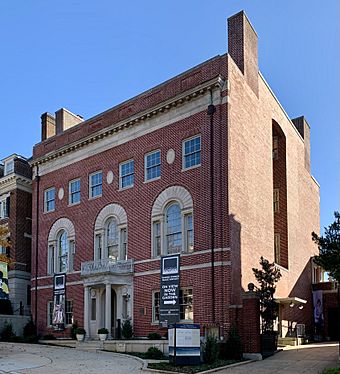Woodrow Wilson House (Washington, D.C.) facts for kids
|
Woodrow Wilson House
|
|

The Woodrow Wilson House in November 2020
|
|
| Location | 2340 S St., NW Washington, D.C., U.S. |
|---|---|
| Area | less than one acre |
| Built | 1915 |
| Architect | Waddy Butler Wood |
| Architectural style | Georgian Revival |
| NRHP reference No. | 66000873 |
Quick facts for kids Significant dates |
|
| Added to NRHP | October 15, 1966 |
| Designated NHL | July 19, 1964 |
The Woodrow Wilson House was the residence of the 28th president of the United States, Woodrow Wilson after he left office. It is at 2340 S Street NW just off Washington, D.C.'s Embassy Row. On February 3, 1924, Wilson died in an upstairs bedroom. It was designated a National Historic Landmark in 1964. The National Trust for Historic Preservation owns the house and operates it as a museum.
History
The house was built by Henry Fairbanks in 1915 on a design by prominent masonic Washington architect Waddy Wood. President Woodrow Wilson bought it in the last months of his second term as President of the United States as a gift to his wife, Edith Bolling Wilson. He presented her the deed in December 1920, although he had never seen the house. The former president and his wife moved into the home on Inauguration Day, which in 1921 was March 4 (not the current date of January 20). Wilson made several modifications to the house, including a billiard room, stacks for his library of over 8,000 books, and a one-story brick garage.
It was from the balcony of the house that Wilson addressed a crowd on November 11, 1923, as his last public appearance. While the Wilsons had few guests, former British Prime Minister David Lloyd George and former French Prime Minister Georges Clemenceau visited the ailing former president at the house.
After Wilson's death in 1924, Edith Wilson lived in the residence until her death on December 28, 1961. She hosted First Lady Jacqueline Kennedy for a brunch in the formal dining room. Edith bequeathed the property and all of its original furnishings to the National Trust for Historic Preservation upon her death.
See also


